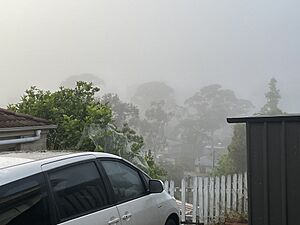Hornsby Heights, New South Wales facts for kids
Quick facts for kids Hornsby HeightsSydney, New South Wales |
|||||||||||||||
|---|---|---|---|---|---|---|---|---|---|---|---|---|---|---|---|

Hornsby Heights viewed from Rofe Park
|
|||||||||||||||
| Population | 6,354 (2021 census) | ||||||||||||||
| • Density | 616.9/km2 (1,598/sq mi) | ||||||||||||||
| Postcode(s) | 2077 | ||||||||||||||
| Elevation | 192 m (630 ft) | ||||||||||||||
| Area | 10.3 km2 (4.0 sq mi) | ||||||||||||||
| Location | 26 km (16 mi) from Sydney CBD | ||||||||||||||
| LGA(s) | Hornsby Shire | ||||||||||||||
| State electorate(s) | Hornsby | ||||||||||||||
| Federal Division(s) | Berowra | ||||||||||||||
|
|||||||||||||||
Hornsby Heights is a lovely suburb located in Northern Sydney, New South Wales, Australia. It's about 26 kilometres north-west of the main city centre of Sydney. This area is part of the Hornsby Shire local government area and is often thought of as part of Sydney's Upper North Shore.
Hornsby Heights sits mostly on high, narrow ridges of the Hornsby Plateau. It's surrounded by beautiful, rugged bushland, including the Galston Gorge and the Berowra Valley National Park. These natural areas form its northern, western, and eastern borders. To the south and south-east, it meets the suburbs of Hornsby and Asquith. You can only drive into Hornsby Heights from the south through Hornsby, or from the north-west via Galston Gorge.
The suburb is known for its leafy, bushland feel. Many short streets lead to quiet dead-end roads, branching off the two main roads: Galston Road and Sommerville Road. Some streets are quite steep because they were built into the valleys to make the most of the land near the ridge edges.
Contents
History of Hornsby Heights
The name Hornsby comes from a man named Samuel Henry Horne. He was a Constable (like a police officer) who helped catch some bushrangers (outlaws) back in 1830. Because of his help, he was given some land, which he called Hornsby Place.
Who Lives in Hornsby Heights?
At the time of the 2021 census, there were 6,354 people living in Hornsby Heights. Most people living here have English, Australian, Irish, Scottish, or Chinese backgrounds. About 67.8% of the residents were born in Australia. Other common birthplaces include England, China, India, New Zealand, and South Africa.
Most people (77.7%) speak only English at home. Mandarin is another language spoken by some families (4.5%). When it comes to religion, many people said they had no religion (41.5%), while others were Catholic (18.9%) or Anglican (14.6%).
Amazing Animals and Plants
Hornsby Heights is full of amazing wildlife! Many different birds and animals often visit people's homes. You might spot Kangaroos, wallabies, common ringtail possums, and even echidnas (spiny anteaters). For birds, rainbow lorikeets, noisy miners, and sulphur-crested cockatoos are very common.
The plants here are typical of the native Australian bushland found around Hornsby. Because it's a bushland area, there's a risk of bushfires in summer. That's why Hornsby Heights has its own Rural Fire Service Brigade to help keep everyone safe.
Parks and Green Spaces
Hornsby Heights has lots of parks and green areas. The suburb is surrounded by the Berowra Valley Regional Park, which is a huge natural space.
Inside Hornsby Heights, you'll find Rofe Park and Montview Oval. Rofe Park is on Galston Road and even has a special area where dogs can run around off-leash. Crosslands Reserve, a great spot for camping and picnics, is at the very northern end of Hornsby Heights. There are also smaller parks like Ulolo and Leonora Close Park, hidden away on quiet streets.
A part of the famous Great North Walk trail, which goes from Galston Gorge to Crosslands, runs along the western edge of Hornsby Heights.
Getting Around Hornsby Heights
Hornsby Heights has a bus service, route number 596, run by CDC NSW. The bus travels in a loop from Hornsby railway station. It covers Galston Road, Somerville Road, and the area around Montview Oval (Montview Parade and McKay Road).
Schools in the Area
There are two public schools that serve the area: Hornsby Heights Public School and Hornsby North Public School. Hornsby North Public School is right on the border between Hornsby and Hornsby Heights. Hornsby Heights Public School celebrated its 50th birthday in 2011, which means it has been teaching kids for a long time!
Places of Worship
- Saint Luke's Anglican Church is located at 155 Galston Road.
- Hornsby Heights is part of the Ku-ring-gai Chase Catholic parish.
- Hornsby Heights Baptist Church is at 110A Galston Road, right next to the local shops.
Community Life and Clubs
Hornsby Heights has several groups where people can get together and have fun or help the community.
Clubs for Fun
- Hornsby Heights Sports Club: A great place for sports and activities.
- 1st Hornsby Heights Scout Group: For kids and teens who love adventure and learning new skills.
- St Luke's Railway Modellers Club: For those who enjoy building and playing with model trains.
Helping the Community
The NSW Rural Fire Service has its Hornsby & Hornsby Heights Brigades located at 143 Galston Road. These brave volunteers help protect the community from bushfires.
Images for kids
-
Rofe Park, used as a helicopter base during a bushfire.


